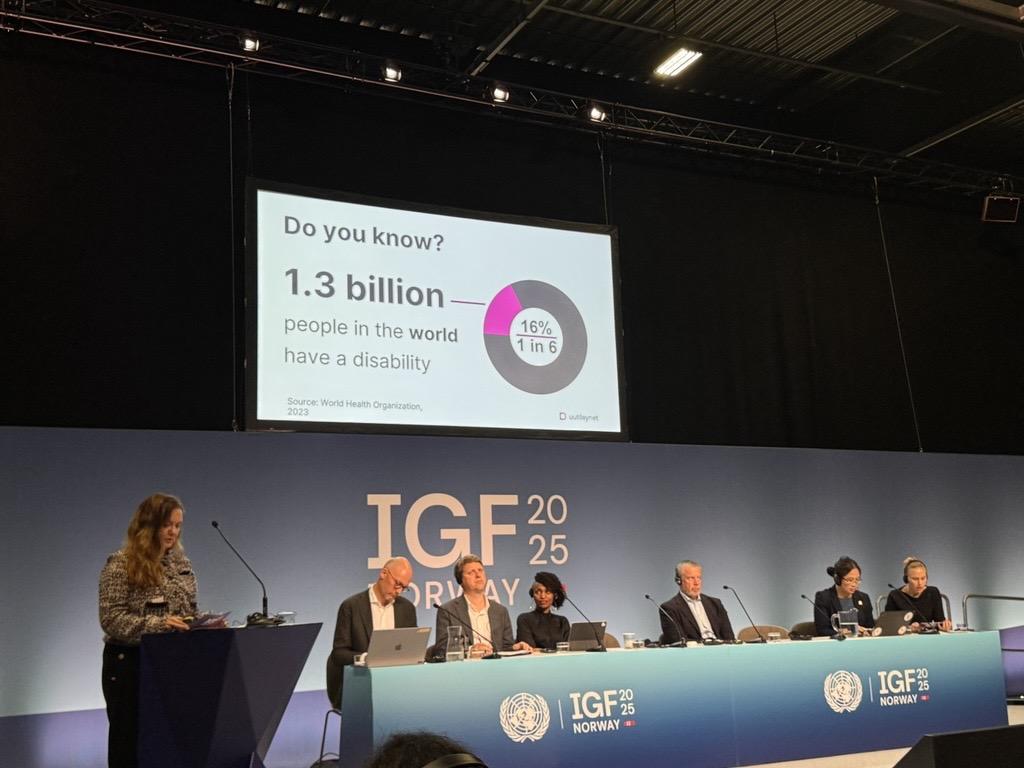This week, Malin Rygg took part in a session at the Internet Governance Forum (IGF) on digital inclusion. In this blog post, she shares her reflections from the session No One Left Behind: Digital inclusion as a Human Right in the Global Digital Age.
From Rights to Reality: What Inclusion Demands
In my keynote, I spoke about how inclusion is about more than access. The ability to participate fully in digital life depends on three tightly linked factors:
- Connectivity – affordable infrastructure and devices
- Accessibility – universal design and assistive technologies
- Digital skills – not just for users, but for the designers and developers of the systems we use every day
As we discussed in the session, one in six people globally lives with a disability. If we want a society where everyone can reach their potential – in education, work, and civic life – we must ensure digital environments are designed to be inclusive from the start. This isn’t just ethically right. It’s also smart policy – and good business. Including the 15% who are currently digitally excluded isn’t just about fixing a gap; it’s about unlocking global potential.

Shared Lessons from North and South
Our session highlighted how different parts of the world are tackling inclusion in different – and sometimes surprisingly aligned – ways. We heard how the European Union’s accessibility regulation and standards have become a reference point not just across Europe, but also for countries like Canada, New Zealand, and Kenya, which recently adopted a national ICT accessibility standard.
In Africa, we see how mobile-first strategies, combined with a youthful population and early adoption of digital standards, offer enormous potential to leap ahead – avoiding many of the design pitfalls experienced in the Global North.
Bridging the Gap – together
So how do we move forward?
One of the most powerful tools we have is a shared framework — one that acknowledges the interconnectedness of individual and societal barriers. The Gap Model we presented offers a way to structure our efforts:
| Dimension | Societal level | Individual level |
|---|---|---|
| Connectivity | Infrastructure, affordability | Devices and internet-enabled tools |
| Accessibility | Regulations, universal design standards | Assistive tech, user-friendly interfaces |
| Digital skills | Competence among developers & institutions | User literacy, confidence, lifelong learning |
Each of these gaps must be addressed in parallel – and globally. As several panelists noted, it’s not just about country-by-country solutions; we need global cooperation to ensure harmonised standards, shared learning, and regulatory alignment.
Key Takeaways from the Session
- Digital inclusion must be recognised and protected as a fundamental human right.
- Standardisation matters. Common frameworks for accessibility and regulation enable interoperability, trust, and usability across borders.
- Designing for inclusion starts with mindset. Competence among developers and service providers is as crucial as digital skills among users.
Three Calls to Action
- Align standards and regulation globally. Let’s build on the positive momentum between EU, US, and partner countries to harmonise rules that serve people.
- Invest in inclusive competence. Digital literacy matters, but so does the competence of those designing systems. We must build both.
- Listen to and include the Global South. Innovation often flourishes where challenges are most pressing – and inclusive practices are embedded early.
Gratitude – and Momentum
I’m deeply grateful to all those who participated in this panel – including our thoughtful moderator, Fredrik Matheson, and inspiring voices like Irene Mbari-Kirika, Inmaculada Porrero, Maja Brynteson, Yu Ping Chan and Dan Sjöblom.
Their insights were a powerful reminder that while our contexts differ, our commitment is shared. If we want a digital future that works for everyone, we must co-create it – across sectors, across regions, and with respect for everyone’s dignity and rights.
Let’s keep going – together.

Malin Rygg
Malin Rygg er direktør i Tilsynet for universell utforming av ikt i Digitaliseringsdirektoratet. Malin er jurist med erfaring frå blant anna Konkurransetilsynet og har tidlegare jobba som advokat og dommar.

